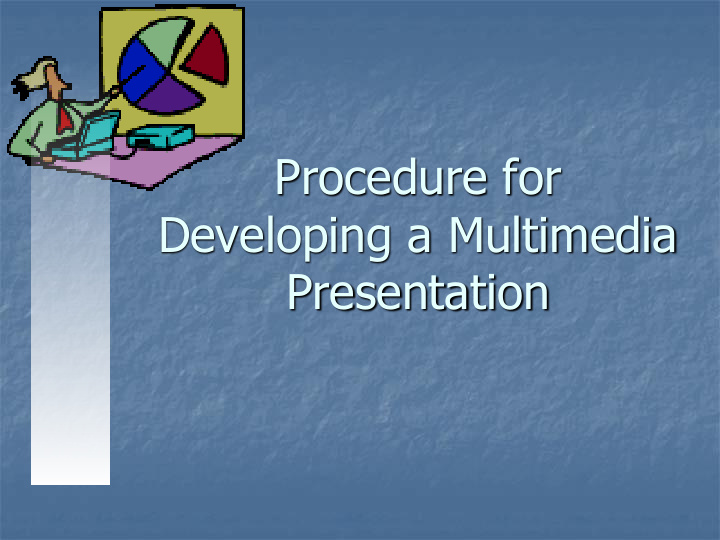



Procedure for Developing a Multimedia Presentation
Procedure for Developing a Multimedia Presentation These first two steps were covered earlier. They are a part of the procedure for creating a multimedia presentation and must be included, but will not be described again in detail in this presentation. Step 1 – Determine the purpose of the presentation Step 2 – Identify the target audience Slide 2
Step 3 - Storyboard the content A storyboard is a collection of frames on a piece of paper Used to determine the number of slides needed Used to organize the content of the presentation 6.02 Apply procedures to develop multimedia presentations used in business. Slide 3
Step 4 – Select a design Appropriate for the purpose of the presentation Templates may be used For example, use a beach template if preparing a presentation to be delivered at a youth retreat at Atlantic Beach 6.02 Apply procedures to develop multimedia presentations used in business. Slide 4
Step 5 – Edit the master slide Make any global changes to the template in this step. Anything applied to the master slide will be applied to all slides in the presentation Items to consider editing: Format the footer Edit background colors Edit font sizes and styles Edit bullets Add logos or graphics that will appear on every slide Adjust line spacing 6.02 Apply procedures to develop multimedia presentations used in business. Slide 5
Step 6 – Enter the content Rule of sevens Appropriate language and grammar Correct any spelling errors 6.02 Apply procedures to develop multimedia presentations used in business. Slide 6
Step 7 – Add and format graphics, audio, and video (optional) Graphics Used to enhance, not distract Place image close enough to the text it illustrates Don’t make image too big or too small Consistent use of graphic types Don’t mix cartoons with photographic images File size of image should not slow presentation Audio and Video How will the file play? Will the file be embedded or linked? Determine the volume level 6.02 Apply procedures to develop multimedia presentations used in business. Slide 7
Step 8 – Add animations and transitions (optional) Animation adds visual interest and emphasizes key parts Can be applied manually and/or an animation scheme can be used Transitions control the flow of information 6.02 Apply procedures to develop multimedia presentations used in business. Slide 8
Step 9 – Practice! Practice the timing Practice speech patterns (tone, speed, transition phrases) 6.02 Apply procedures to develop multimedia presentations used in business. Slide 9
Step 10: Revise as needed Repeat Steps 4-9 as needed to fine-tune the presentation 6.02 Apply procedures to develop multimedia presentations used in business. Slide 10
Transitions Transitions determine how the presentation will progress from one slide to the next. Random transitions can be set globally to the entire presentation or individually. The speed of the each transition should be consistent and enhance the message. 6.02 Apply procedures to develop multimedia presentations used in business. Slide 11
Determine how the video or audio will play Looped (continuous play) On mouse click Automatically 6.02 Apply procedures to develop multimedia presentations used in business. Slide 12
Linked A linked object means that the container (presentation file) merely saves the actual filename, as opposed to the whole file. If linked, make sure the presentation, including all supporting files are packaged before saving to another computer 6.02 Apply procedures to develop multimedia presentations used in business. Slide 13
Embedded An embedded object is actually stored in the container (presentation file) rather than pointing to a linked document or file somewhere else. 6.02 Apply procedures to develop multimedia presentations used in business. Slide 14
Animation Make text and pictures fly in, bounce, and zoom out using animation. Animate text by word, letter, or line and add dimming and sound effects. Use entrance and exit effects to fade pictures in and out with items in a bulleted list. Use dimming to keep the reader focused on the content Use emphasis to stress key points 6.02 Apply procedures to develop multimedia presentations used in business. Slide 15
Animation Schemes A preset animation scheme ties together several types of animation effects that complement each other. A scheme is a polished sequence of effects that can be applied to several slides or the whole show. 6.02 Apply procedures to develop multimedia presentations used in business. Slide 16
Recommend
More recommend